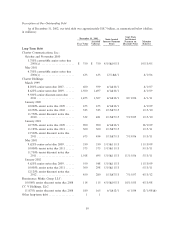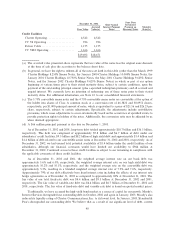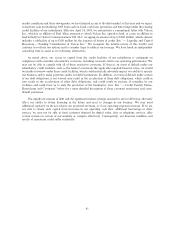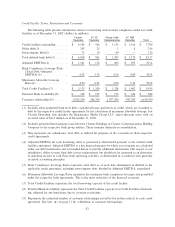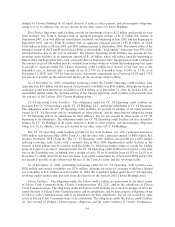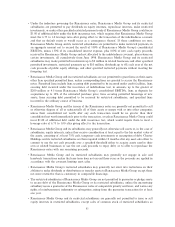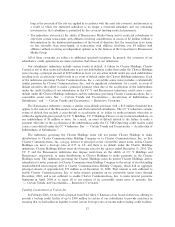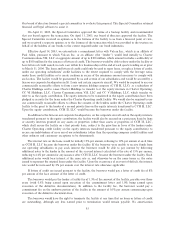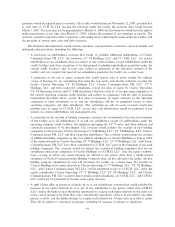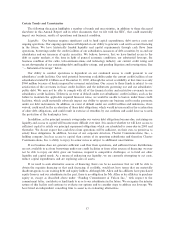Charter 2002 Annual Report Download - page 49
Download and view the complete annual report
Please find page 49 of the 2002 Charter annual report below. You can navigate through the pages in the report by either clicking on the pages listed below, or by using the keyword search tool below to find specific information within the annual report.amount plus accrued interest to the repurchase date. See ""Ì Certain Trends and Uncertainties Ì Long-Term
Indebtedness Ì Change of Control Payments.''
High Yield Restrictive Covenants; Limitation on Indebtedness. The indentures governing the public
notes of our subsidiaries contain certain covenants that restrict the ability of Charter Holdings, Charter
Capital, the CC V notes issuers, Renaissance Media Group, and, as described below, their respective
restricted subsidiaries to:
‚ incur additional debt;
‚ pay dividends on equity or repurchase equity;
‚ grant liens;
‚ make investments;
‚ sell all or substantially all of our assets or merge with or into other companies;
‚ sell assets;
‚ enter into sale-leasebacks;
‚ in the case of restricted subsidiaries, create or permit to exist dividend or payment restrictions with
respect to the bond issuers, guarantee the bond issuers' debt, or issue speciÑed equity interests; and
‚ engage in certain transactions with aÇliates.
The particular restrictions applicable to our various high yield notes are discussed in greater detail below.
Summary of Restrictive Covenants under Charter Holdings High Yield Notes. The limitations on
incurrence of debt and issuance of preferred stock contained in Charter Holdings' indentures permit Charter
Holdings and its subsidiaries to incur additional debt or issue preferred stock, so long as there is no default
under the Charter Holdings indentures. These limitations restrict the incurrence of debt except for:
‚ additional debt, if, after giving pro forma eÅect to the incurrence, Charter Holdings could meet a
leverage ratio (ratio of consolidated debt to four times EBITDA from the most recent quarter) of 8.75
to 1.0, and, regardless of whether the leverage ratio could be met,
‚ up to $3.5 billion of debt under credit facilities,
‚ up to $75 million of debt incurred to Ñnance the purchase of new assets,
‚ up to $300 million of additional debt,
‚ an amount equal to 200% of proceeds of new cash equity proceeds received by Charter Holdings and its
restricted subsidiaries since March 1999, the date of our Ñrst indenture, and not allocated for restricted
payments or permitted investments, and
‚ other items of indebtedness for speciÑc purposes such as intercompany debt, reÑnancing of existing
debt, and interest rate swaps to provide protection against Öuctuation in interest rates.
The restricted subsidiaries of Charter Holdings are generally not permitted to issue debt securities
contractually subordinated to other debt of the issuing subsidiary or preferred stock, in either case in any
public or Rule 144A oÅering.
The Charter Holdings indentures permit Charter Holdings and its restricted subsidiaries to incur debt
under one category, and later reclassify that debt into another category. Our subsidiaries' credit agreements
generally impose more restrictive limitations on incurring new debt than Charter Holdings' indentures, so our
subsidiaries that are subject to credit agreements are not permitted to utilize the full debt incurrence that
would otherwise be available under the Charter Holdings indenture covenants.
47




